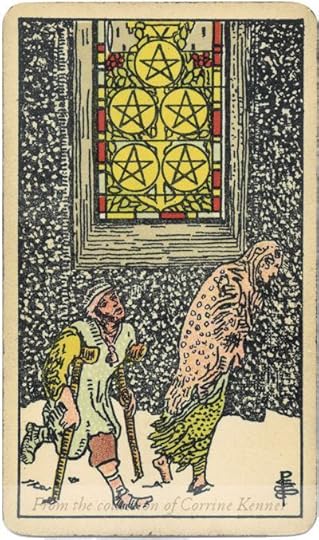Ash Wednesday and the Five of Pentacles

Today is Ash Wednesday, which marks the start of Lent: forty days of penance, reflection, and fasting. A lot of Christians will be walking around with smudges of ash on their foreheads — but otherwise, they'll look like their usual selves.
Centuries ago, they probably would have looked more like the figures in the Five of Pentacles.
Normally, the card is associated with hope and guidance, because most of us have been taught to turn to the church during times of trouble. Traditionally, it's the one place we know we can find spiritual support. Most churches also offer emergency assistance to people in physical need, too.
There was a time, though, when some congregants deliberately turned their backs on the church — because they didn't believe they deserved the blessings and forgiveness they could find in the House of God. On Ash Wednesday, they dressed in sackcloth and ashes, and they were ritually cast out of the sanctuary to contemplate their faith.
Think about that: there was a ritual in which some believers could voluntarily be thrown out of church.
Today, a lot of people have turned their back on organized religion, because it doesn't seem to meet their spiritual needs. Most leave with at least some feelings of bitterness and recrimination.
In a tarot reading, the Five of Pentacles can be a gentle reminder to reclaim their faith, even if they need to find a new structure for its expression.
Personally, I think the concept of Lent is remarkable. For most people, a forty-day period of intentional separation and contemplation would certainly be easier than forty years of estrangement.
I also like the concept of Lent as a time to reconcile our thoughts and deeds with our spiritual beliefs. We could all use that "time out" once a year.
. . .
Here's a good description of Ash Wednesday from Catholic.org:
Ash Wednesday marks the beginning of the Season of Lent. It is a season of penance, reflection, and fasting which prepares us for Christ's Resurrection on Easter Sunday, through which we attain redemption.
Why we receive the ashesFollowing the example of the Ninevites, who did penance in sackcloth and ashes, our foreheads are marked with ashes to humble our hearts and reminds us that life passes away on Earth. We remember this when we are told
"Remember, Man is dust, and unto dust you shall return."
Ashes are a symbol of penance made sacramental by the blessing of the Church, and they help us develop a spirit of humility and sacrifice.
The distribution of ashes comes from a ceremony of ages past. Christians who had committed grave faults performed public penance. On Ash Wednesday, the Bishop blessed the hair shirts which they were to wear during the forty days of penance, and sprinkled over them ashes made from the palms from the previous year. Then, while the faithful recited the Seven Penitential Psalms, the penitents were turned out of the church because of their sins — just as Adam, the first man, was turned out of Paradise because of his disobedience. The penitents did not enter the church again until Maundy Thursday after having won reconciliation by the toil of forty days' penance and sacramental absolution. Later, all Christians, whether public or secret penitents, came to receive ashes out of devotion. In earlier times, the distribution of ashes was followed by a penitential procession.
The AshesThe ashes are made from the blessed palms used in the Palm Sunday celebration of the previous year. The ashes are christened with Holy Water and are scented by exposure to incense. While the ashes symbolize penance and contrition, they are also a reminder that God is gracious and merciful to those who call on Him with repentant hearts. His Divine mercy is of utmost importance during the season of Lent, and the Church calls on us to seek that mercy during the entire Lenten season with reflection, prayer and penance.
Image Note
The Five of Pentacles card that illustrates this post is from an original "Pam B" Rider-Waite tarot deck that was probably printed in the 1920s.











